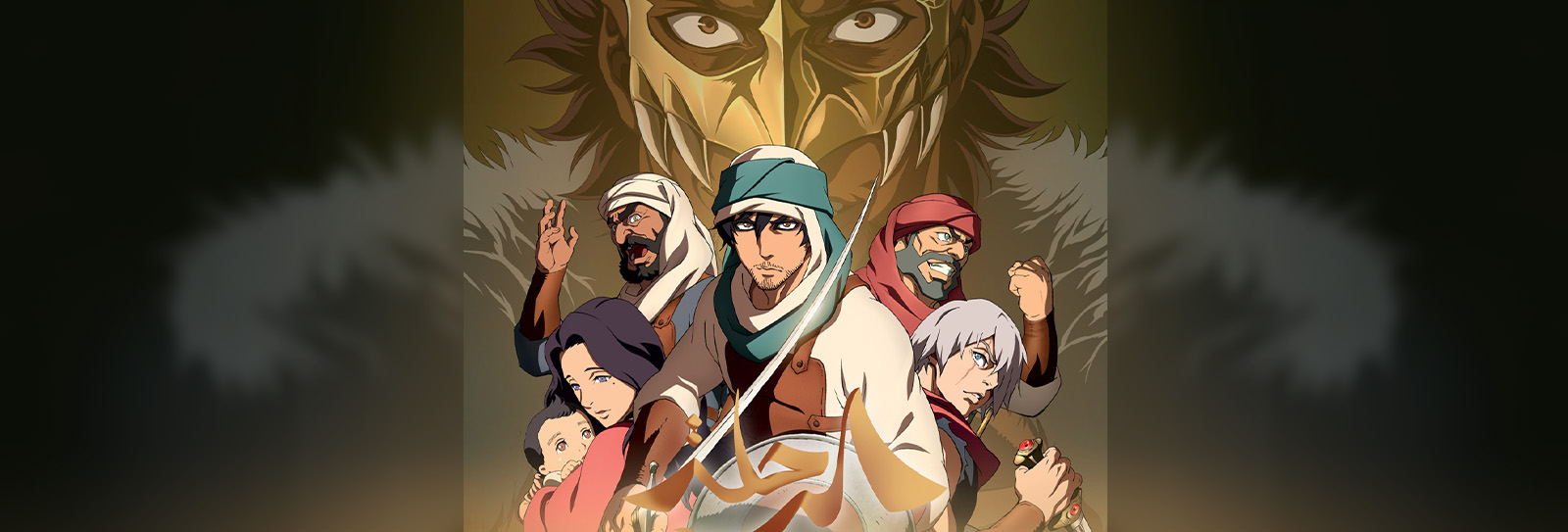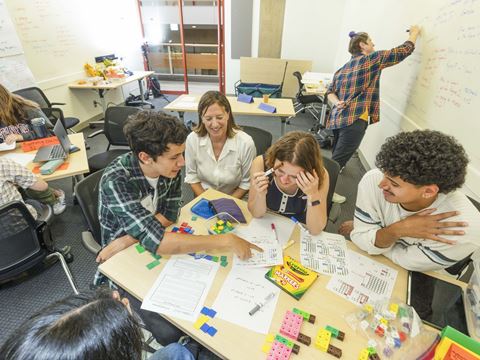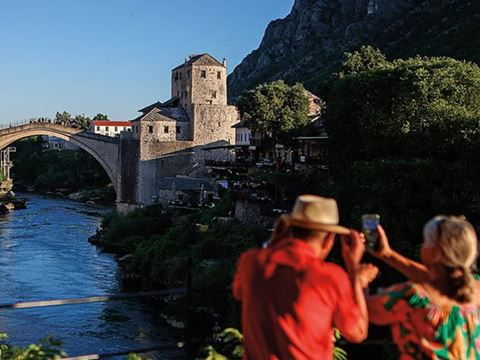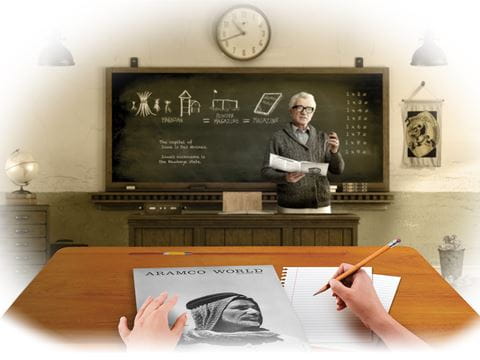
Bringing Cultures Together Through Anime
Art
Geography
History
Arab Gulf
Think about what happens when artists from two very different cultures join forces to create something new.
The following activities and abridged text build off “Animated Narratives for New Eyes,” written by Matthew Teller and photographed by Naoki Miyashita.
WARM UP
Scan the article’s photos and captions to predict its main idea and theme.
IF YOU ONLY HAVE 15 MINUTES ...
Identify what Japanese and Arab artists brought to their anime collaboration.
IF YOU ONLY HAVE 30 MINUTES ...
Identify the benefits and challenges of cross-cultural collaboration, and reflect on how to facilitate future joint efforts.
VISUAL ANALYSIS
Consider how a photograph affects a viewer and how the effect might change if the photo changed.
Directions: As you read, you will notice certain words are highlighted. See if you can figure out what these words mean based on the context. Then click the word to see if you’re right.
Animated Narratives for New Eyes
The date is sometime in 2018. The scene is an upper floor of a modest office building in Tokyo, Japan. The building is the headquarters of Toei Animation, one of Japan’s oldest and best-known animated-film-production companies. Mohammed Aldhafeeri adjusts his traditional Arab shamagh wrapped around his head and prepares for battle.
Toei staffers were enthralled as Aldhafeeri squared up to his brother. The two are similarly dressed in a thawb—a men’s ankle-length robe, tucked in at the waist. They are armed with carefully designed cardboard swords. Cameras recorded the “battle,” as the two men exchanged good-natured blows.

“We were models,” says Aldhafeeri. He was born and raised in Riyadh, Saudi Arabia, but lived and worked 12 years in Japan. The Toei staffers were trying to animate a battle scene from ancient Arabia. But they weren’t succeeding, due to their lack of firsthand historical knowledge.
They needed to see how the fabric of a shamagh and how a thawb moved in the air, how a traditional Arabian sword differed from more familiar Japanese weapons. To help, Aldhafeeri made costumes and brought them to the office to wear in front of his Japanese colleagues. They studied them closely. Aldhafeeri also created weapons and other cultural artifacts to be as authentic as possible. “In the end, we broke both swords—it was a long fight!” he laughs.
Question: Why was it difficult for the staff artists at Toei to animate a battle scene from ancient Arabia?
They had a lack of firsthand historical knowledge.
The battle scene formed part of The Journey, a unique coproduction between Japan and Saudi Arabia. The film is part of a growing field of animated movies, or “anime” (AN-ee-may). The animation style is distinctly Japanese. It uses bright colors, bold lines, flat backdrops and complex, dramatic storylines. It is similar to manga—a related Japanese art form of printed graphic novels and comic books. The characters display strong emotions through facial expressions and body movements. Community, loyalty and collective purpose underpin many narratives. Almost entirely absent is the lone superhero figure of American comic books.

In many parts of the world, cartoons may be dismissed as kids’ stuff, but in Japan, manga and anime are hugely popular. Nearly every town has a store selling manga. Many broadcast and streaming channels feature anime series of all genres and styles. Some content is aimed solely at children or teens. Other content addresses adult concerns like war, social issues, sex and spirituality.
In the 1970s and ’80s, Japanese pop culture spread internationally. TV networks across the world began to screen anime dubbed into local languages. By the time the very successful series, Pokémon, premiered in 1997, anime was already in demand across the United States, Europe and farther afield.
Anime is very popular with a global generation. One example is Captain Tsubasa. The story centers on the exploits of soccer prodigy Tsubasa Oozora and his friends. It first appeared in 1981 in a serialized manga magazine. Then, it was broadcast on Japanese television. Still in demand, a new TV series premiered in late 2023.
In the Arabic-speaking world, Captain Tsubasa became Captain Majid. Many young adults who played video games as kids watched anime like Capitan Majid. Everything was dubbed into Arabic. Khalid Alshaye, a businessman born and raised in Riyadh says, adding, “I had no idea it was Japanese. I just loved it.
Syrian writer Obada Kassoumah, 33, has mentioned how the streets in his neighborhood of Damascus were empty when Captain Majid came on TV. He and his school friends tuned in for the latest episode. Then, headed out to reproduce Majid’s soccer tricks. “Once I tried to copy Majid so hard, I knocked myself out,” Kassoumah says.
The ubiquity of TV anime feeds a growing appetite for the art form. Anime has become “wildly popular in Saudi Arabia and the [Middle East],” writes Washington-based analyst Daniel Sharp, with Saudi Arabia hosting “the largest anime fan base in the region.”

Saudi Anime Expo attendees enjoy playing with dubbing The Journey at Manga Productions’ booth. The experience demonstrates the popularity in the country of both the film’s origin story and anime.
In 2017 the Saudi kingdom’s nonprofit Misk Foundation funded an animation studio, Manga Productions. It is a company that produces manga, anime and video games. There had already been some experimental short films made as Japan-Saudi co-productions. But a 2017 partnership between Toei and Manga opened the door for a full-length animated feature. As part of the agreement, some 300 Saudi creatives moved to Tokyo to work with Toei Animation.
Question: What were the outcomes of the Misk Foundation's funding for Manga Productions?
It opened the door for a full-length animated feature, and 300 Saudi creatives moved to Tokyo to work with Toei Animation.
Script development originated in Riyadh, under the title The Journey. The story was based on the legend of Abraha, a sixth-century ruler of the kingdom of Axum, now modern-day Ethiopia and Yemen. Abraha led a vast army attacking Makkah, only to be repulsed by divine intervention. The tale is well-known from the Qur’an but is referenced there in only five short verses.


Creative content director Sara Oulddaddah, 32, is part of a creative community at Manga Productions that is 70 percent women. She explains how The Journey’s Arab writing teams stuck to the basic story, but also gave themselves freedom to introduce new characters. “We imagined, ‘What if this character had fought Abraha’s invasion and witnessed the incredible outcome of this uneven battle?’” Oulddaddah says.
With a story outline in place, responsibility moved to Japanese screenwriter Atsuhiro Tomioka and Japanese director Kobun Shizuno. “Early on, I went to Riyadh to meet the Saudi creative team,” Shizuno, 50, says. “Their style was different, and I wanted to learn from them. From the start, I knew that we would be able to create something unique.” That exchange went both ways. Saudi artists and animators also moved to Tokyo to work alongside their Japanese counterparts.
“It was a challenge,” he grins. “I was working directly with the Japanese teams, and there was a lot of misunderstanding to start with.”

Oulddaddah clarifies that the misunderstandings were cultural. “For example, when we would discuss a sad scene, the Japanese team would think of rain. But for us as Saudis, when we see rain, we are happy. It’s very subtle, and it was fascinating to realize things we think are common sense are very different for other cultures,” she says.
Body language was another complication. “If someone is angry, in Arabic we use a lot of hand gestures. In Japanese, they prefer expressions or body movement,” she says. All these issues needed working through.
Question: List two cultural misunderstandings the staff from Saudi creatives had with their Japanese counterparts.
1. The word rain made the Japanese team feel sad. The word rain made the Saudi team happy.
2. In speaking Arabic, people use hand gestures. In Japanese, they prefer expressions of body movements.
One of the contrasts proved especially positive. The Saudi artists were mostly younger than 35. The Japanese team were mostly in their 40s and older. The age difference “really enriched the creative process. We never felt there was a power imbalance. Both sides were really eager to understand each other,” Oulddaddah says.

The result looks Japanese, feels Japanese and—in its original version—sounds Japanese. Nonetheless the Qur’anic story is steeped in Arab tradition. The final production is visually spectacular and conceptually groundbreaking in its cultural blend. It gives Saudi audiences stories told from their perspective using a popular foreign medium.
Although The Journey was ready by early 2020, the COVID-19 pandemic delayed its release. It eventually opened in Japan and Saudi Arabia in June 2021 in Japanese and Arabic versions. An English dub screened in the US in 2022, and a German-language dub also followed. The movie was made available worldwide on anime streaming service Crunchyroll. Anime critics declared the film “richly thought-provoking,” and an amalgamation of Arab and Japanese culture.

One of the film ’s most distinctive elements is cutting away from the action at crucial points. Nested within the main narrative arc are three mini stories. These sequences are told in flashback. They draw upon the Qur’anic tales of Noah, Moses and the mysterious lost city known as Iram of the Pillars. Each sequence has a unique look, in contrast with the fluid action of the main story. These sequences reflect director Shizuno’s skill in adopting the story-within-a-story technique familiar from traditional Arabic folktales.
Oulddaddah reflects positively on the production. “We recognize that Japan has exceptional creative power in this industry. Our aim with this collaboration was to transfer that knowledge to our team, to raise our own production capability,” she says.
Internships and training programs run by Manga Productions continue to foster creative exchange between the two countries. Saudi enthusiasm for Japanese pop culture shows no sign of waning. In 2022 and 2023, Manga Productions announced new partnerships to develop two of Japan’s best-known anime franchises: Grendizer—the space robot and Captain Tsubasa.
“There are so many ways now to approach the market, and these stories carry such strong moral lessons,” Manga Productions development executive Alshaye says. He speaks of a tide of Japanese creators eager to develop content for Arab audiences, and notes that that is starting to have an impact. “Directors are becoming more aware of Arab cultural influences, writing Arab characters and even hiring Arab voice actors in original Japanese productions.”
Question: List different activities related to the production of the film The Journey that fostered cultural exchange between Saudi Arabia and Japan.
Internships and training programs; new partnerships to develop new anime franchises; Japanese creators eager to develop content for Arab audiences; hiring Arab voice actors in original Japanese productions.
As The Journey producer Shinji Shimizu remarks with a twinkle: “The journey has just begun.”
Other lessons

How To Improve Student Confidence Through Seeing Math Differently
For the Teacher's Desk
Hands-on activities shift math from memorization to exploration—building confidence and curiosity in the classroom.
The Mostar Bridge Over Troubled Waters: A Case Study in Reconciliation.
History
Language Studies
Europe
Learn how the idioms and metaphors of a bridge destroyed during the Bosnian Civil War express the sentiment of a people.
Teaching Empathy: Five Classroom Activities From AramcoWorld
For the Teacher's Desk
Help students build empathy and community for the academic year with AramcoWorld’s stories and Learning Center lessons.